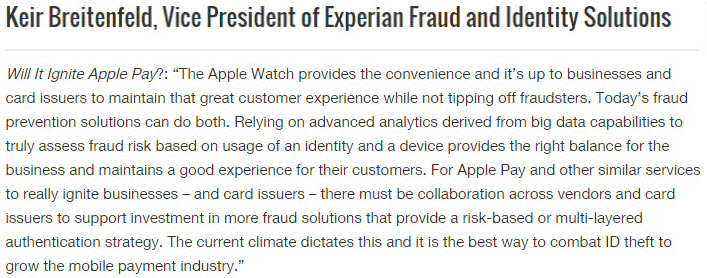Tag: identity theft

We’re excited to announce Family Account Management: a new feature available for our partners that makes it easy for their subscribers to extend identity protection services to family and friends. Family Account Management allows our partners to offer quick and easy enrollment, enabling new subscribers to opt in to a family plan by inputting family or friends’ email addresses within their portal. Subscribers can invite anyone of the age of 18 to join. Every family has different security needs and preferences. This feature offers plan options that can be configured to match the primary subscriber’s current enrolled services, or customized to include a set of services that best suits each family’s needs. The Consumer Sentinel Network, a division of the Federal Trade Commission, reported over 1.2 million fraud-related complaints in 2015. With identity fraud on the rise, we need to be more vigilant than ever before and take steps to improve our own security and the security of our loved ones. We all have unique identity elements, including birthday, email address, and Social Security number, and monitoring one person’s identity elements won’t minimize risk for other family members. That’s why Family Account Management is so important, allowing subscribers to extend coverage for what matters most – family. “Families are more connected than ever before, but with more ways to stay connected, there are new threats putting families at risk of identity theft,” said Joe Ross, Experian President and Co-Founder. “With Family Account Management, businesses can provide their subscribers with an easy and convenient way to extend identity protection services to their loved ones.” Visit our website for more information on identity protection products you can offer your customers and stay up to date with all Experian news on LinkedIn.

Internet-connected devices provide endless possibilities, but they rely on technology and collected data to deliver on their promises. This can compromise your network security. Follow these tips to enjoy the conveniences provided by Internet of Things devices while keeping your network safe. Look for devices that use end-to-end encryption. Change default passwords before connecting devices to your network. Enable two-factor authentication, when available. Leverage all security options, such as passwords, encryption, firewalls and firmware. The Internet of Things is only as strong as its weakest link. That's why it’s so important to understand and treat each connected device as part of a broader network. More security tips

Fraud and cybersecurity are two of the biggest risks challenging organizations and the economy today. Fraud has become its own industry, to the tune of $500 billion in estimated losses annually. To strengthen your fraud risk strategies, you need: A multilayered authentication and risk-based approach to prevent fraud. A comprehensive approach to identity with true customer intelligence. To avoid silos and recognize the value of combining your solutions into one platform. The rapid growth of fraud-related activity only reinforces the need for aggressive fraud prevention strategies and the adoption of new technology to prepare for the latest emerging cybersecurity threats. Want to know more?

Experian is recognized as a leading security solution provider for fraud and identity solutions in order to protect customers and financial institutions

Unfortunately, identity theft can happen to anyone and has far-reaching consequences for its victims. According to the US Department of Justice (DOJ)’s most recent study, 17.6 million people in the US experience some form of identity theft each year. This includes activities such as fraudulent credit card transactions or personal information being used to open unauthorized accounts. The most obvious consequence that identity theft victims encounter is financial loss, which comes in two forms: direct and indirect. Direct financial loss refers to the amount of money stolen or misused by the identity theft offender. Indirect financial loss includes any outside costs associated with identity theft, like legal fees or overdraft charges. The DOJ’s study found that victims experienced a combined average loss of $1,343. In total, identity theft victims lost a whopping $15.4 billion in 2014. Beyond money lost, identity theft can negatively impact credit scores. While credit card companies detect a majority of credit card fraud cases, the rest can go undetected for extended periods of time. A criminal’s delinquent payments, cash loans, or even foreclosures slowly manifest into weakened credit scores. Victims often only discover the problem when they are denied for a loan or credit card application. Last year, Experian found that these types of fraud take the longest time to resolve. Identity theft doesn’t just impact victims financially; it also often takes a significant emotional toll. A survey from the Identity Theft Research Center found that 69 percent felt fear for their personal financial security, and 65 percent felt rage or anger. And, almost 40 percent reported some sleep disruption. These feelings increased over time when victims were unable to settle the issue on their own, according to the report, which can result in problem as work or school, and add stress to relationships with friends and family. Thankfully, consumers are getting smarter about the best ways to protect their information, like using monitoring services or following security best practices. How are you protecting yourself against identity theft? Learn more about our Identity Protection Services

Did you know that identities can shift (for better or worse) in just 30 days? To succeed in today’s multichannel, mobile environment, businesses must have a broader, more dynamic identity management strategy that includes: Identity proofing: Point-in-time verification (e.g., account opening) Authentication: Ongoing verification (e.g., account login) Identity management: Continual monitoring throughout the Customer Life Cycle Minimize your identity fraud risk, increase customer engagement and provide a satisfying customer experience by shifting to a strategy focused on identity relationship management. >>The three pillars of identity relationship management

A recent Experian study reveals that tax filing, document collection and refund processing are done online more often, yet only 6% of consumers file taxes on a computer with up-to-date antivirus software. 79% filed their most recent tax return online, up from 73% in 2011 18% scan and save their tax documents electronically, up from 6% in 2011 More than 75% of respondents have used EFT for tax refunds As electronic filing continues to grow, identity theft is likely to increase. While consumers should take steps to protect themselves, businesses also need to employ identity theft protection solutions to safeguard consumer information. >> Identify and prevent fraud

A recent Experian survey shows a growing concern over identity theft and tax fraud. 42% of consumers are concerned that someone could access their personal data through their tax return, compared with 35% in 2014 and 38% in 2015 28% of consumers have been a victim or know someone who has been a victim of tax fraud Tax season is a busy time of year for identity thieves. While consumers should take steps to protect themselves, businesses also need to employ ID theft protection solutions in order to safeguard consumer information. >> Identify and prevent multiple types of fraud

It may seem like April is far away, but tax season in fact launches next Tuesday, January 19. And whether you’re a business or an individual, you’ll want to know if you’re eligible for any tax benefits. Thanks to a recent announcement from the Internal Revenue Service (IRS), identity theft protection will now be considered a non-taxable benefit – a nod to the rising importance of the service for all consumers in today’s security landscape. The IRS will treat identity theft protection as a non-taxable, non-reportable benefit—for any employee or company, regardless of whether they’ve experienced a data breach, or whether the identity theft protection is provided by an employer to employees or by a business to its customers. Previously, only employees or customers who were in the aftermath of a data breach could treat identity theft monitoring as a non-taxable event. But after that announcement just four months ago, several businesses suggested a data breach was not a remote risk, but rather, “inevitable.” What does this mean for companies? They can now deduct any cost of offering identity theft protection to their employees or customers. The IRS defines identity theft protection services as: Credit report and monitoring services Identity theft insurance policies Identity restoration services Other similar services It’s important to note that these don’t need to be reported on either W-2 or 1099-MISC forms. However, this new policy won’t apply to cash given to employees or customers in place of identity protection services. Perhaps the change in defining what qualifies was spurred by the IRS’s need to provide identity theft protection last summer, as its online database of past-filed returns and other documents was hacked. That breach affected over 300,000 individuals. Whatever the reason, the announcement means this is a perfect time to sign up for identity theft monitoring services. You can do so through an employer or directly with a retailer. Particularly for individuals, the ability to receive tax benefits while knowing your personally identifiable information is safe and secure is a great feeling. For existing subscribers, upgrading to premium services may now be a more viable option. Does your company offer identity theft protection and monitoring as an employee benefit? If not, would this announcement change their minds? Visit our website for more information on identity protection products you can offer your customers. Learn more

Looking at true fraud rate I’ve talked with many companies over the years about their fraud problems. Most have a genuine desire to operate under the fraud prevention model and eliminate all possible fraud from their systems. The impact on profit is often the primary motivation for implementing solutions, but in reality most companies employ a fraud management schema, offsetting the cost of fraud with the cost of managing it. There are numerous write-ups and studies on the true cost of fraud. What most people don’t realize is that, for each item lost to fraud, a business operating on 10 percent net profit margins will need to sell 10 times the amount of product in order to recover the expense associated with the loss. These hard costs don’t include the soft dollar costs, such as increased call center expenses to handle customer calls. Recently, some organizations have started to add reputational risk into their cost-of-fraud equation. With the proliferation of social media, a few unhappy customers who have been victims of fraud easily can impact an organization’s reputation. This is an emerging fuzzy cost that eventually can be tied back to lost revenue or a drop in share price. Most companies say with pride that their acceptable fraud rate is zero. But when it comes time to choose a partner in fraud detection, it almost always comes down to return on investment. How much fraud can be stopped — and at what price? More informed organizations take all operational expenses and metrics into consideration, but many look at vendor price as the only cost. It’s at this point that they start to increase their acceptable fraud rate. In other words, if — hypothetically — Vendor A can stop only 80 percent of the fraud compared with Vendor B, but Vendor A costs less than 80 percent of what Vendor B costs, they’ll choose Vendor A. All of a sudden, their acceptable fraud rate is no longer zero. This method of decision making is like saying we’ll turn off the security cameras for 20 percent of the day because we can save money on electricity. On the surface, I understand. You have to be accountable to the shareholders. You have to spend and invest responsibly. Everyone is under pressure to perform financially. How many executives, however, take the time to see where those lost dollars end up? If they knew where the money went, would they change their view? We must be vigilant and keep our acceptable fraud rate at zero.
A recent Experian survey found that while consumers are getting better about protecting their information on a regular basis, many do not take the same precautions when traveling. According to the survey, 1 in 5 consumers has had an item with sensitive information lost or stolen while traveling, and 39% have experienced identity theft while traveling or know someone who has. Organizations can protect themselves and customers by using innovative fraud-detection tools designed to reduce potential losses while preserving the customer experience. >> Video: The reputational impact of fraud and identity theft

Apple Pay fraud solution Apple Pay is here and so are increased fraud exposures, confirmed losses, and customer experience challenges among card issuers. The exposure associated with the provisioning of credit and debit cards to the Apple Pay application was in time expected as fraudsters are the first group to find weaknesses. Evidence from issuers and analyst reports points to fraud as the result of established credit/debit cards compromised through data breaches or other means that are being enrolled into Apple Pay accounts – and being used to make large value purchases at large merchants. Keir Breitenfeld, our vice president of Fraud and Identity solutions said as much in a recent PYMNTS.com story where he was quoted about whether the Apple Watch will help grown Apple Pay. The challenge is that card issuers have no real controls over the provisioning or enrollment process so they currently only have an opportunity to authenticate their cardholder, but not the provisioning device. Fraud exposure can lie within call centers and online existing customer treatment channels due to: Identity theft and account takeover based on breach activity. Use of counterfeit or breached card data. Call center authentication process inadequacies. Capacity and customer experience pressures driving human error or subjectively lax due diligence. Existing customer/account authentication practices not tuned to this emerging scheme and level of risk. The good news is that positive improvements have been proven with bolstering risk-based authentication at the card provisioning process points by comparing the inbound provisioning device to the device that is on file for the cardholder account. This, in combination with traditional identity risk analytics, verifications, knowledge-based authentication, and holistic decisioning policies vastly improve the view afforded to card issuers for layered process point decisioning. Learn more on why emerging channels, like mobile payments, call for advanced fraud identification techniques.

Reputational impact of fraud It’s all over the news. Hackers are compromising personal information and using that to access customer accounts. It’s critical that organizations have technology in place to distinguish valid customers from fraudsters as quickly as possible. The impact of fraud on the customer relationship requires more elaborate and accurate fraud prevention. Customers have a legitimate expectation that the institutions with which they do business will safeguard their identities, accounts and sensitive data. When fraud or a data breach occurs, that trust can be broken. All the work an institution has done to build its brand image can be damaged suddenly. With the right controls in place, even when customer information is compromised organizations can easily tell the difference between good customers and fraudsters. Listen to what Matt Lane, Experian's 41st Parameter vice president of customer management, says about the reputational impact of fraud theft on an organization: Learn more about the reputational impact of fraud thefts on an organization.

Did you know that privacy policies do not guarantee that your information will be kept private? Most companies use privacy policies to inform customers about how their personal information may be used, i.e. sold, shared, exchanged, not necessarily guaranteeing absolute confidentiality. In today’s increasingly digital world where exchanging personal information – your name, email address, home address, etc. – for access to websites, coupons and the like has become the norm. And, it can be difficult for consumers to understand the value of their personal information. Today is the eighth annual Data Privacy Day, an international awareness effort spearheaded by the National Cyber Security Alliance (NCSA) that encourages all Internet users to consider the privacy implications of their online actions and motivate all companies to make privacy and data protection a greater priority. Since most consumers aren’t fully aware of the implications of sharing personal information, we’re taking a deeper look at what can happen when personal information is shared online. Companies that collect don’t always protect When you share personal information with a company online, that company is responsible for protecting your information. Even data that is seemingly harmless is extremely valuable to cyber criminals, like your email address or your mother’s maiden name for a password reset. When you share this valuable, personal information with a company online be sure to read the company’s privacy policy fine print in order to be certain that your information is not being shared publicly or with outside companies. In some instances, even reading the company’s fine print cannot keep your information safe. Millions were affected last year due to retail and medical data breaches, proving it difficult for companies to protect your data no matter how secure it may seem. Once cyber criminals have their hands on your personal information, you may be surprised at what they can do with it. Cyber criminals patch together your digital profile Bits and pieces of personal information stolen from companies can help cyber criminals patch together a complete picture of your digital identity. They can then use your digital identity to access more important information like your financial records from retail sites that have your credit card information stored. Many consumers leave a trail of personal information on the Internet, leading cyber criminals to steal your identity and your financial information. How to make a difference during Data Privacy Day Here are some tips on how you can increase your privacy online from the NCSA: Think of your personal information like money – value it and protect it. You are often paying for “free” services with your personal information. Before you willingly provide your information to a service, make sure it is a business you trust to handle your information with care. Manage your browser cookies to maximize your privacy and prevent unwanted tracking. Demand that businesses be honest about how they collect, use and share personal information. Be cautious about who you “friend” and communicate with online. Visit our website for more information on identity protection products you can offer your customers.

A recent survey reveals that 30 percent of travelers have experienced identity theft while traveling or know someone who has.